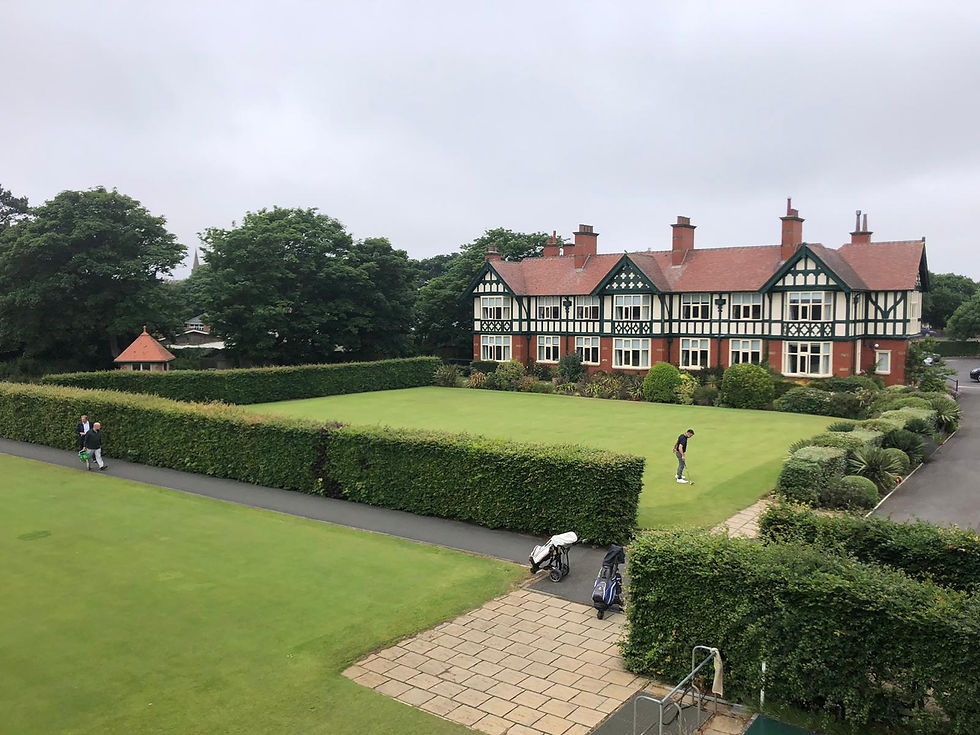
What happened next?
One of Question of Sport’s most famous captains and rugby union legend Sir Bill Beaumont began chatting to me on the driving range of his home course.
Later, Sir Bill’s group played through our quartet as we searched for yet another ball in the fierce rough and he again summed up the bonhomie of Royal Lytham & St Anne’s.
“Has it met your expectation?” he asked as he trundled past.

It certainly had and so, so much more.
Anyone who has an interest in the history of golf must visit the venue of eleven Open championships.
We had the delight of being invited by an international member who lives in Estonia but had grown up within a stone’s throw of the links.
He gave us the guided tour to a clubhouse which is akin to a museum of golf. There is a homage to Seve which almost prompted a tear of reverence alongside the club’s own trophy cabinet (if the members are good enough, they can lift a silver kettle or, even more bizarrely, a giant shrimp!).

At lunch we sat on the balcony where chatting onlookers had been told to be quiet as Gary Player flicked his famous backhanded wall putt on to the green in 1974.
I could have gone home satisfied before we even hit a ball on the famous old links (is it a links if it is a couple of miles inland?) but I am glad I didn’t.

It is a privilege to attack the first hole – a par three which sums up Royal Lytham. Keep out of trouble and success can follow. Find a bunker and it probably won’t.
I had watched endless instruction videos because of the course’s infamous 174 deep sand traps.
I knew all about the need for a wide stance, lowering my tailbone (I didn’t even know I had one before last week), a wedge which could balance a wine glass and smashing the sand hard.
The problem was that I didn’t expect to have to put practice into play quite as often or the bunkers to be quite as steep.
Anyway, they bore significant responsibility for my inability to register anything like a good score.

Nevertheless, I could appreciate the glories of this historic course.
Every hole has been described countless times by people with greater knowledge than me, so I shall resist giving my less-than-expert view on all of them
Instead, I shall stick to my personal takeaways.

I was enamoured of the holes which ascended while running parallel to the railway track which appeared to be a magnet for errant drives (seriously, how many balls hit trains?).
The 7th was a stand-out for me – a par five which demands that even great tee shots weave between bunkers before an attack to a green which is guarded by more greedy traps and a grassed dune.
Having been chastened on day one, I played it thoughtfully on day two only to three putt!
Ah, did I mention the mystery of Royal Lytham’s greens? They all appear to be flat and straight and yet none of our group, including one compadre who had a superb round, could sink anything about eight feet. I still don’t know why.

I digress.
The 8th was my personal favourite. A short par four to a green perched high, forcing a shot over three traps akin to gaping whale mouths beneath it.

The only hole which I felt was a bit out of sync was the 13th – yes, it has the usual deep bunkers and greenside trees which stand at about 70 degrees as a symbol of how the wind can get up but it seemed something of an afterthought in my opinion.
I agreed with our host that the 15th is a brute of a par four and that the 17th is a great hole with a dogleg which inspires big decisions about whether to risk a blind second shot over the corner with heavy rough and bunkers lurking.

And then there is the 18th. Surely, one of the greatest holes in golf.
On the second day, our host insisted that we play from the championship tees and was so right to do so.

We felt what it must be like to have the eyes of 45,000 spectators and the TV commentators describing every move.
When I lowered my tailbone for the umpteenth time and clipped it out of the greenside bunker to within seven feet I could imagine their acclaim. After I missed the putt, I could visualise them groaning and slipping off to the bar without offering a single clap.
Royal Lytham & St. Anne’s is an unbelievably good course, its history is superbly presented and I was lucky enough to play it in wonderful company.
But our visit would not have shone as much if it hadn’t been for the friendliness of its welcome.

From the steward as we walked in the steps of giants into the fabled clubhouse, to the staff serving our ample lunch, the accommodating team in the pro shop, the members such as Sir Bill wishing us well and the poor lass who sat in the halfway house for half an hour waiting for the last round of the day to come past, this was natural hospitality.
What happened next?
We had the time of our lives.

コメント